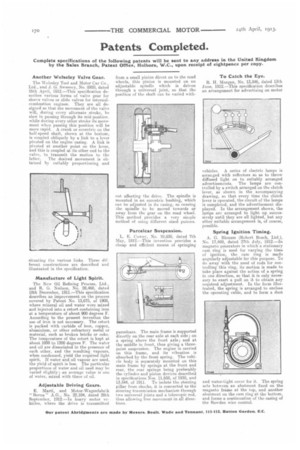Patents Completed.
Page 24

If you've noticed an error in this article please click here to report it so we can fix it.
Complete specifications of the following patents will be sent to any address in the United Kingdom by the Sales Branch, Patent Office, Holborn, W.C., upon receipt of eightpence per copy.
Another Wolseley Valve Gear.
The Wolseley Tool and Motor Car Co., Ltd., aid J. G. Sweeney, No. 8928, dated 16th April, 1912.—This specification describes various forms of valve gear for sleeve valves or slide valves for internalcombustion engines. They are all designed so that the movement of the valve will, during every alternate stroke, be slow in passing through its mid-position, while during every other stroke its movement when passing this position will be more rapid. A crank or eccentric on the half-speed shaft, shown at the bottom, is coupled obliquely by a link to a lever pivoted on the engine casing. A link is pivoted at another point on the lever, and this is coupled at its other end to the valve, to transmit the motion to the latter. The desired movement is obtained by suitably proportioning and Manufacture of Light Spirit.
The New Oil Refining Process, Ltd.. and R. G. Neilson No. 28,460, dated 18th December, 191i.—This specification describes an improvement on the process covered by Patent No. 13,675, of 1908, where mineral oil and water were mixed and injected into a retort containing iron at a temperature of about 900 degrees F. According to the present invention the use of iron is not necessary. The retort is packed with carbide of iron, copper, aluminium, or other refractory metal or material, such as broken bricks or coke. The temperature of the retort is kept at about 1000 to 1200 degrees F. The water and oil are dissociated in the presence of each other, and the resulting vapours, when condensed, yield the required light spirit. 11 water and oil vapour are used, the yield of spirit is less. The particular proportions of water and oil used may be varied slightly ; an average value is one of water, mixed with three of oil.
Adjustable Driving Gears.
E. Marti, and Motor-Wagenfabrik " Berna " A.G. No. 22,104, dated 28th September, 1912.—In heavy motor vehicles, where the drive is transmitted from a small pinion direct on to the road wheels, this pinion is mounted on an adjustable spindle which is driven through a universal joint, so that the position of the shaft can be varied with
out affecting the drive. The spindle is mounted in an eccentric bushing, which can be adjusted in its easing, so causing the spindle to be moved towards or away from the gear on the road wheel. This method provides a very simple method of using different sized pistons.
Parcelcar Suspension.
L. E. Cowey, No. 10,830, dated 7th May, 1912.--This invention provides a cheap and efficient means of springing
pareelcars. The main frame is supported directly on the rear axle at each side ; on a spring above the front axle; and at the middle in front, thus giving a threepoint suspension. The engine is carried on this frame, and its vibration is absorbed by the front spring. The vehicle body is separately mounted on this main frame by springs at the front and rear, the rear springs being preferably the cylinder and piston devices described in specifications Nos. 11,658, of 1910, and 13.544, of 1911. To isolate the steering pillar from shocks, it is connected to the steering transmission mechanism through two universal joints and a telescopic rod, thus allowing free movement in all directions. To Catch the Eye.
R. H. Morgan, No. 13,846, dated 13th June, 1912.—This specification describes an arrangement for advertising on motor
vehicles. A series of electric lamps is arranged with reflectors so as to throw diffused light on to suitably arranged advertisements. The lamps are controlled by a switch arranged on the clutch lever, as shown in the accompanying drawing, so that every time the clutch lever is operated, the circuit of the lamps is completed, and the advertisement displayed. In the arrangement shown, the lamps are arranged to light up successively until they are all lighted, but any other suitable arrangement is, of course, possible.
Spring Ignition Timing.
A. G. Bloxam (Robert Bosch, Ltd.), No. 17,489, dated 27th July, 1912.—In magneto generators in which a stationary cam ring is used for varying the time of ignition, the cam ring is made angularly adjustable for this purpose. To do away with the need of rods for controlling this ring, its motion is made to take place against the action of a spring in one direction, so that it is only necessary to exert a pull on it to obtain any required adjustment. In the form illustrated, the spring is arranged to enclose the operating cable, and to form a dust
and water-tight cover for it. The spring acts between an abutment fixed on the magneto frame at the top, and another abutment on the cam ring at the bottom, and forms a continuation of the casing of the Bowden wire control.
























